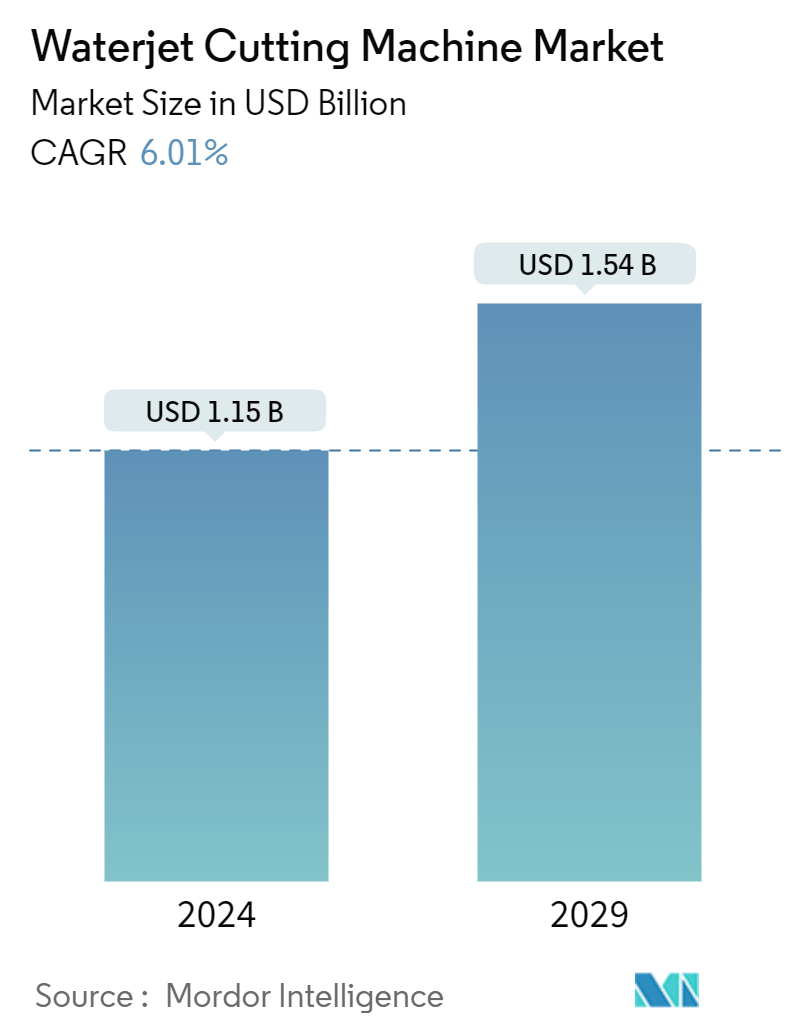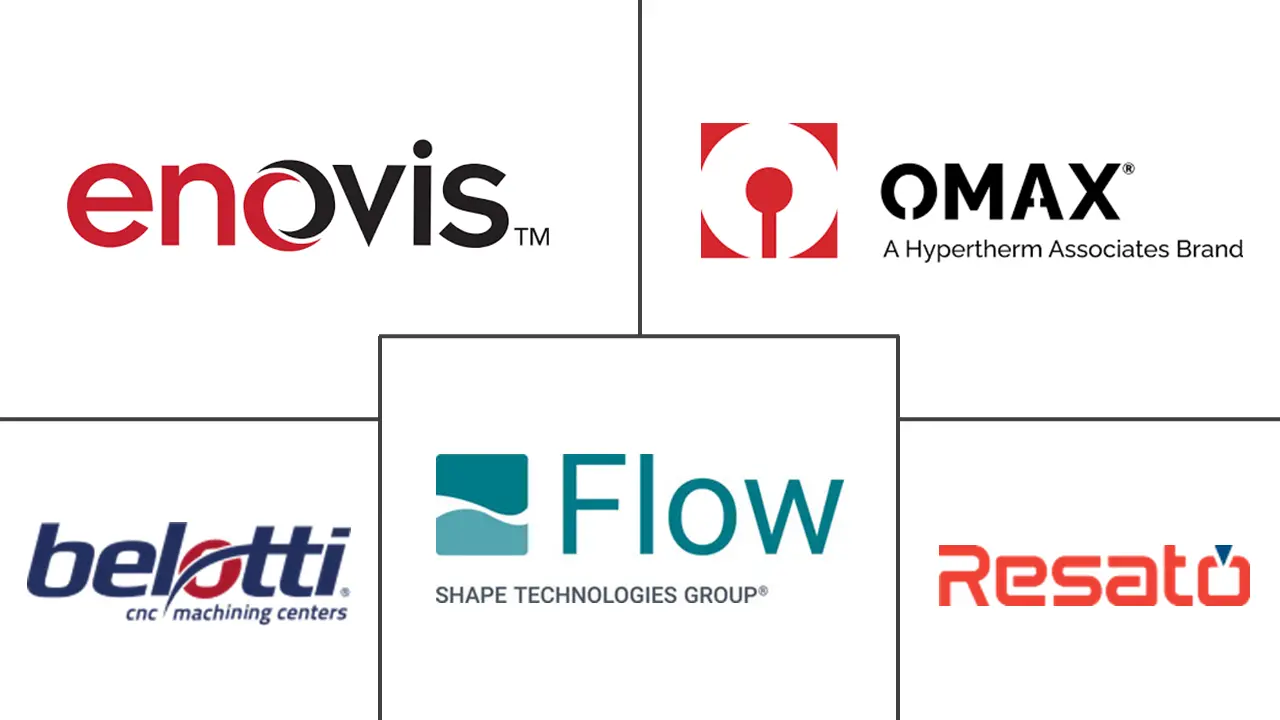Market Size of Waterjet Cutting Machine Industry

| Study Period | 2020 - 2029 |
| Market Size (2024) | USD 1.15 Billion |
| Market Size (2029) | USD 1.54 Billion |
| CAGR (2024 - 2029) | 6.01 % |
| Fastest Growing Market | North America |
| Largest Market | Asia-Pacific |
| Market Concentration | Low |
Major Players
*Disclaimer: Major Players sorted in no particular order |
Waterjet Cutting Machine Market Analysis
The Waterjet Cutting Machine Market size is estimated at USD 1.15 billion in 2024, and is expected to reach USD 1.54 billion by 2029, growing at a CAGR of 6.01% during the forecast period (2024-2029).
The waterjet cutting machine market is a dynamic and rapidly evolving segment within the broader industrial machinery industry. Known for its precision and versatility, waterjet cutting technology has become essential across various industries, including automotive, aerospace, electronics, and construction. This technology allows for cutting diverse materials—ranging from metals and composites to ceramics and glass—without compromising their structural integrity, making it indispensable for modern manufacturing processes.
Waterjet Cutting Equipment and Technology
Diverse Equipment Types: Waterjet cutting equipment is categorized into several types, each designed to meet specific industrial needs. These include robotic, 3D, and micro waterjet cutting systems. Robotic systems provide automation capabilities, enhancing productivity by reducing manual intervention. Meanwhile, micro waterjet systems are tailored for ultra-precision applications, particularly in industries where small components require intricate cuts.
Technological Advancements: Recent advancements have significantly improved the efficiency and accuracy of waterjet cutting machines. High-pressure waterjet systems, coupled with Computer Numerical Control (CNC) technology, have revolutionized the cutting process, allowing for precise and complex geometries to be cut with minimal human error. The non-thermal nature of waterjet cutting eliminates heat-affected zones, making it ideal for temperature-sensitive materials.
Expanding Applications in Manufacturing
Aerospace and Automotive Sectors: The aerospace and automotive industries are among the key drivers of the waterjet cutting machine market. In aerospace, the technology's precision in cutting materials like titanium and composites is crucial for producing high-quality components. In the automotive industry, waterjet cutting is used to create intricate shapes and designs in materials such as aluminum, steel, and plastics, essential for modern vehicle manufacturing. The shift towards electric vehicles (EVs) and the use of lightweight materials further boost the demand for waterjet cutting technology.
Electronics and Semiconductor Manufacturing: The electronics industry, particularly in semiconductor manufacturing, demands highly precise cutting methods for delicate materials like silicon wafers and printed circuit boards (PCBs). Waterjet cutting, especially micro waterjet systems, has become increasingly popular in this sector due to its ability to make fine, intricate cuts without damaging sensitive components. As the demand for smaller, more complex electronic devices grows, the adoption of waterjet cutting technology in this industry is expected to increase.
Technological Innovations Driving Market Growth
High-Pressure Waterjet Systems: The development of high-pressure and ultra-high-pressure waterjet systems has expanded the range of applications for waterjet cutting technology. These systems allow for faster cutting of thicker and harder materials, improving operational efficiency. Additionally, innovations in pump technology have enhanced energy efficiency, reducing operational costs and making waterjet cutting more accessible to small and medium-sized enterprises (SMEs).
CNC Integration for Enhanced Precision: The integration of CNC technology into waterjet cutting machines has been a game-changer, enabling automated, highly precise cutting operations. CNC-controlled waterjet systems can execute complex geometries and patterns with minimal human intervention, significantly reducing material wastage and improving productivity. This technology is particularly valuable in industries requiring high precision, such as aerospace and electronics.
Waterjet Cutting Machine Industry Segmentation
The word "waterjet cutting machine" refers to a water jet at extremely high pressure or a water and abrasive mixture used in a waterjet cutting machine, an industrial device that can cut a wide range of materials. Water is required for the operation of a waterjet cutting machine as a key raw material, and eco-friendly abrasive materials are utilized in the process. Waterjet cutting machines are used to shape, cut, and ream in many industries, such as aerospace and mining.
The report provides a comprehensive background analysis of the waterjet cutting machine market, covering the current market trends, restraints, technological updates, and detailed information on various segments and the competitive landscape of the industry. Additionally, the COVID-19 impact has been incorporated and considered during the study.
The Waterjet Cutting Machine market is segmented by Product Type (Robotic Waterjet Cutting, 3D Waterjet Cutting, Micro Waterjet Cutting), Industry (Automotive, Electronics, Aerospace, Construction, Mining Industry, Other Industries), and Geography (North America, South America, Europe, Asia-Pacific, and the Middle East). The report offers market size and forecast in terms of value (USD million) for all the above segments.
| Product Type | |
| Robotic Waterjet Cutting | |
| 3D Waterjet Cutting | |
| Micro Waterjet Cutting |
| End-User | |
| Automative | |
| Electronics | |
| Aerospace | |
| Construction | |
| Mining Industry | |
| Other Industries |
| Geography | ||||||||
| ||||||||
| ||||||||
| ||||||||
| ||||||||
|
Waterjet Cutting Machine Market Size Summary
The waterjet cutting machine market is experiencing growth driven by rapid industrialization and the expansion of end-use industries such as automotive and manufacturing. The integration of robotic systems and automation in manufacturing processes has significantly contributed to this market's expansion. Waterjet cutting machines are favored for their efficiency, requiring minimal setup time and capable of cutting a diverse range of materials. Advanced technologies like 3D and multi-axis cutting are enhancing the capabilities and applications of waterjet cutting, making them more accessible and widely used across various sectors. Despite challenges posed by the COVID-19 pandemic, the market is recovering as production facilities resume operations, focusing on safeguarding personnel and supply chains.
The market is characterized by its adaptability and technological advancements, with waterjet cutting technology gaining popularity for its ability to cut materials such as composites, metals, and glass with precision. The adoption of automation has further improved efficiency and safety in manufacturing environments, particularly in industries like aerospace and medical devices. The competitive landscape is fragmented, with numerous local and international players striving to innovate and integrate cutting-edge technologies. Key industry players, including OMAX Corporation and Flow International Corporation, are leading the market with advanced products that address specific industry challenges. The market's growth is supported by increasing demand for modern equipment and governmental support for pure waterjet technology, indicating a promising future for the industry.
Waterjet Cutting Machine Market Size - Table of Contents
-
1. MARKET INSIGHTS & DYNAMICS
-
1.1 Current Market Overview
-
1.2 Market Drivers
-
1.2.1 Surging Demand from the Manufacturing and Automotive Sectors
-
1.2.2 Technological Advancements
-
-
1.3 Market Restraints
-
1.3.1 High Initial Investment and Maintenance Costs
-
-
1.4 Market Opportunities
-
1.4.1 Increasing Uptake in Developing Regions
-
-
1.5 Technological Advancements
-
1.6 Industry Attractiveness - Porter's Five Forces Analysis
-
1.6.1 Threat of New Entrants
-
1.6.2 Bargaining Power of Buyers/Consumers
-
1.6.3 Bargaining Power of Suppliers
-
1.6.4 Threat of Substitute Products
-
1.6.5 Intensity of Competitive Rivalry
-
-
1.7 Impact of Geopolitics and Pandemics on the Market
-
-
2. MARKET SEGMENTATION
-
2.1 Product Type
-
2.1.1 Robotic Waterjet Cutting
-
2.1.2 3D Waterjet Cutting
-
2.1.3 Micro Waterjet Cutting
-
-
2.2 End-User
-
2.2.1 Automative
-
2.2.2 Electronics
-
2.2.3 Aerospace
-
2.2.4 Construction
-
2.2.5 Mining Industry
-
2.2.6 Other Industries
-
-
2.3 Geography
-
2.3.1 North America
-
2.3.1.1 United States
-
2.3.1.2 Canada
-
2.3.1.3 Mexico
-
2.3.1.4 Rest of North America
-
-
2.3.2 South America
-
2.3.2.1 Brazil
-
2.3.2.2 Argentina
-
-
2.3.3 Europe
-
2.3.3.1 Germany
-
2.3.3.2 United Kingdom
-
2.3.3.3 France
-
2.3.3.4 Russia
-
2.3.3.5 Spain
-
2.3.3.6 Rest of Europe
-
-
2.3.4 Asia-Pacific
-
2.3.4.1 India
-
2.3.4.2 China
-
2.3.4.3 Japan
-
2.3.4.4 Rest of Asia-Pacific
-
-
2.3.5 Middle East
-
2.3.5.1 United Arab Emirates
-
2.3.5.2 Saudi Arabia
-
2.3.5.3 Rest of the Middle East
-
-
-
Waterjet Cutting Machine Market Size FAQs
How big is the Waterjet Cutting Machine Market?
The Waterjet Cutting Machine Market size is expected to reach USD 1.15 billion in 2024 and grow at a CAGR of 6.01% to reach USD 1.54 billion by 2029.
What is the current Waterjet Cutting Machine Market size?
In 2024, the Waterjet Cutting Machine Market size is expected to reach USD 1.15 billion.

